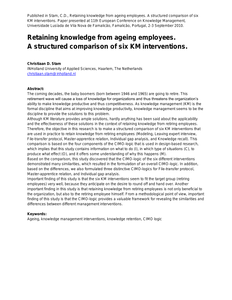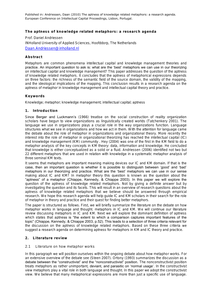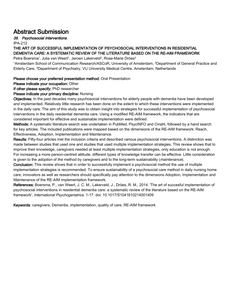The coming decades, the baby boomers (born between 1946 and 1965) are going to retire. This retirement wave will cause a loss of knowledge for organizations and thus threatens the organization‟s ability to make knowledge productive and thus competitiveness. As knowledge management (KM) is the formal discipline that aims at improving knowledge productivity, knowledge management seems to be the discipline to provide the solutions to this problem. Although KM literature provides ample solutions, hardly anything has been said about the applicability and the effectiveness of these solutions in the context of retaining knowledge from retiring employees. Therefore, the objective in this research is to make a structured comparison of six KM interventions that are used in practice to retain knowledge from retiring employees (Modeling, Leaving expert interview, File-transfer protocol, Master-apprentice relation, Individual gap analysis, and Knowledge recall). This comparison is based on the four components of the CIMO-logic that is used in design-based research, which implies that this study contains information on what to do (I), in which type of situations (C), to produce what effect (O), and it offers some understanding of why this happens (M). Based on the comparison, this study discovered that the CIMO-logic of the six different interventions demonstrated many similarities, which resulted in the formulation of an overall CIMO-logic. In addition, based on the differences, we also formulated three distinctive CIMO-logics for File-transfer protocol, Master-apprentice relation, and Individual gap analysis. Important finding of this study is that the six KM interventions seem to fit the target group (retiring employees) very well, because they anticipate on the desire to round off and hand over. Another important finding in this study is that retaining knowledge from retiring employees is not only beneficial to the organization, but also to the retiring employee himself. From a methodological point of view, important finding of this study is that the CIMO-logic provides a valuable framework for revealing the similarities and differences between different management interventions.
DOCUMENT

Abstract: Background: Chronic obstructive pulmonary disease (COPD) and asthma have a high prevalence and disease burden. Blended self-management interventions, which combine eHealth with face-to-face interventions, can help reduce the disease burden. Objective: This systematic review and meta-analysis aims to examine the effectiveness of blended self-management interventions on health-related effectiveness and process outcomes for people with COPD or asthma. Methods: PubMed, Web of Science, COCHRANE Library, Emcare, and Embase were searched in December 2018 and updated in November 2020. Study quality was assessed using the Cochrane risk of bias (ROB) 2 tool and the Grading of Recommendations, Assessment, Development, and Evaluation. Results: A total of 15 COPD and 7 asthma randomized controlled trials were included in this study. The meta-analysis of COPD studies found that the blended intervention showed a small improvement in exercise capacity (standardized mean difference [SMD] 0.48; 95% CI 0.10-0.85) and a significant improvement in the quality of life (QoL; SMD 0.81; 95% CI 0.11-1.51). Blended intervention also reduced the admission rate (relative ratio [RR] 0.61; 95% CI 0.38-0.97). In the COPD systematic review, regarding the exacerbation frequency, both studies found that the intervention reduced exacerbation frequency (RR 0.38; 95% CI 0.26-0.56). A large effect was found on BMI (d=0.81; 95% CI 0.25-1.34); however, the effect was inconclusive because only 1 study was included. Regarding medication adherence, 2 of 3 studies found a moderate effect (d=0.73; 95% CI 0.50-0.96), and 1 study reported a mixed effect. Regarding self-management ability, 1 study reported a large effect (d=1.15; 95% CI 0.66-1.62), and no effect was reported in that study. No effect was found on other process outcomes. The meta-analysis of asthma studies found that blended intervention had a small improvement in lung function (SMD 0.40; 95% CI 0.18-0.62) and QoL (SMD 0.36; 95% CI 0.21-0.50) and a moderate improvement in asthma control (SMD 0.67; 95% CI 0.40-0.93). A large effect was found on BMI (d=1.42; 95% CI 0.28-2.42) and exercise capacity (d=1.50; 95% CI 0.35-2.50); however, 1 study was included per outcome. There was no effect on other outcomes. Furthermore, the majority of the 22 studies showed some concerns about the ROB, and the quality of evidence varied. Conclusions: In patients with COPD, the blended self-management interventions had mixed effects on health-related outcomes, with the strongest evidence found for exercise capacity, QoL, and admission rate. Furthermore, the review suggested that the interventions resulted in small effects on lung function and QoL and a moderate effect on asthma control in patients with asthma. There is some evidence for the effectiveness of blended self-management interventions for patients with COPD and asthma; however, more research is needed. Trial Registration: PROSPERO International Prospective Register of Systematic Reviews CRD42019119894; https://www.crd.york.ac.uk/prospero/display_record.php?RecordID=119894
DOCUMENT

The sources of productivity have always been the main subject of economic debate because they are the main determinants of profitability and competitiveness. In order to improve productivity we should be able to identify the sources of productivity. This article presents a method for measuring the sources of knowledge productivity in order to give direction to knowledge management initiatives. The method is based on a theoretical framework which combines two different perspectives (economic and process) on knowledge productivity. This article presents the methodological and theoretical framework, the initial design of the method and the results of the first two case studies. The relevance of this article is that it combines the concepts of knowledge management and intellectual capital measurement in the relatively new concept of knowledge productivity.
DOCUMENT

Although sustainability is often discussed solely in ecological terms, it cannot be disconnected from the way humans behave in their social environment. This article presents a theoretical approach toward sustainability that takes a human behavior and knowledge view on sustainability as a starting point. This approach requires that human behavior should change, individually and collectively, in order to achieve sustainability. Knowledge is identified as the driving force behind human behavior and its effect on the ecological and social environment. In connecting knowledge with sustainability, two concepts are introduced: knowledge of sustainability (KoS), which refers to the sustainability content of knowledge, and sustainability of knowledge (SoK), which denotes the dynamics of the continuing process of knowledge creation and application. To apply SoK and KoS, we argue that a cognitive interpretation of human behavior should be formulated within a knowledge management approach that incorporates the stages of knowledge creation, integration, and application and that ensures the critical evaluation of created knowledge. In order to show that our new approach is practical, we use existing research from the Dutch starch potato industry to reformulate possibilities for the enhancement of sustainability in terms of KoS and SoK. In addition, the research led to the development of a mechanism for evaluating knowledge. Group interaction, information technology, and decision support systems are used to realize knowledge integration. The combination of conceptual design and domain of application is common in the engineering sciences, where a design methodology is used to make the steps from conceptual design to functional design and technical implementation. A conceptual design may show ways to improve existing practices, which in turn might result in superior practices. Of course, it is necessary to empirically test the interventions in reality. For AGROBIOKON that has not been done, yet. © 2010 M.E. Sharpe, Inc. All rights reserved.
DOCUMENT
Metaphors are common phenomena intellectual capital and knowledge management theories and practice. An important question to ask is: what are the ‗best‘ metaphors we can use in our theorizing on intellectual capital and knowledge management? This paper addresses the question of the aptness of knowledge related metaphors. It concludes that the aptness of metaphorical expressions depends on three factors: the richness of the semantic field of the source domain, the validity of the mapping, and the ideological implications of the mapping. This conclusion results in a research agenda on the aptness of metaphor in knowledge management and intellectual capital theory and practice.
DOCUMENT

In this thesis several studies are presented that have targeted decision making about case management plans in probation. In a case management plan probation officers describe the goals and interventions that should help offenders stop reoffending, and the specific measures necessary to reduce acute risks of recidivism and harm. Such a plan is embedded in a judicial framework, a sanction or advice about the sanction in which these interventions and measures should be executed. The topic of this thesis is the use of structured decision support, and the question is if this can improve decision making about case management plans in probation and subsequently improve the effectiveness of offender supervision. In this chapter we first sketch why structured decision making was introduced in the Dutch probation services. Next we describe the instrument for risk and needs assessment as well as the procedure to develop case management plans that are used by the Dutch probation services and that are investigated in this thesis. Then we describe the setting of the studies and the research questions, and we conclude with an overview of this thesis.
DOCUMENT

Presentatie gegeven over de review in Brussel Objectives: In the past decades many psychosocial interventions for elderly people with dementia have been developed and implemented. Relatively little research has been done on the extent to which these interventions were implemented in the daily care. The aim of this study was to obtain insight into strategies for successful implementation of psychosocial interventions in the daily residential dementia care. Using a modified RE-AIM framework, the indicators that are considered important for effective and sustainable implementation were defined.
MULTIFILE

Background: There is increasing interest in the role that technology can play in improving the vitality of knowledge workers. A promising and widely adopted strategy to attain this goal is to reduce sedentary behavior (SB) and increase physical activity (PA). In this paper, we review the state-of-the-art SB and PA interventions using technology in the office environment. By scoping the existing landscape, we identified current gaps and underexplored possibilities. We discuss opportunities for future development and research on SB and PA interventions using technology. Methods: A systematic search was conducted in the Association for Computing Machinery digital library, the interdisciplinary library Scopus, and the Institute of Electrical and Electronics Engineers Xplore Digital Library to locate peer-reviewed scientific articles detailing SB and PA technology interventions in office environments between 2009 and 2019. Results: The initial search identified 1130 articles, of which 45 studies were included in the analysis. Our scoping review focused on the technologies supporting the interventions, which were coded using a grounded approach. Conclusion: Our findings showed that current SB and PA interventions using technology provide limited possibilities for physically active ways of working as opposed to the common strategy of prompting breaks. Interventions are also often offered as additional systems or services, rather than integrated into existing office infrastructures. With this work, we have mapped different types of interventions and provide an increased understanding of the opportunities for future multidisciplinary development and research of technologies to address sedentary behavior and physical activity in the office context
DOCUMENT

Background and Aim: Caregivers in the home environment have an important role in timely detecting and responding to abuse. The aim of this review was to provide insight into both the existing tools for the assessment of and interventions for elder abuse by formal and informal caregivers in the home environment, and to categorize them according to a public health perspective, into primary, secondary, tertiary or quaternary prevention. Methods: We selected the assessment tools and interventions that can be used by caregivers in the home environment included in previous reviews by Gallione et al (2017) and Fearing et al (2017). To identify published studies after these reviews, a search was performed using PubMed, Cochrane Database, CINAHL and Web of Science. Results: In total, fifteen assessment tools and twelve interventions were included. The number of assessment tools for elder abuse for use in the home environment is increasing; however, tools must be validated over different cultures and risk groups. In addition, the tools lack attention for the needs of vulnerable older persons such as persons with dementia. Existing interventions for caregivers in the home environment lack evidence for addressing elder abuse and do not address potential adverse effects (quaternary prevention). Conclusion: Assessment tools for elder abuse need further testing for validity and reliability for use by caregivers in the home environment. For interventions, meaningful outcome measures are needed. Important to note is that quaternary prevention requires more attention. This argues for taking into account perspectives of (abused) older persons and caregivers in the development of assessment tools and interventions protocols.
DOCUMENT

A case study and method development research of online simulation gaming to enhance youth care knowlegde exchange. Youth care professionals affirm that the application used has enough relevance as an additional tool for knowledge construction about complex cases. They state that the usability of the application is suitable, however some remarks are given to adapt the virtual environment to the special needs of youth care knowledge exchange. The method of online simulation gaming appears to be useful to improve network competences and to explore the hidden professional capacities of the participant as to the construction of situational cognition, discourse participation and the accountability of intervention choices.
DOCUMENT
